UML作业第五次:分析系统,绘制状态图
一、状态图 语法小结
简单状态
使用([*])开始和结束状态图。使用-->添加箭头。
@startuml [*] --> State1 State1 --> [*] State1 : this is a string State1 : this is another string State1 -> State2 State2 --> [*] @enduml

更改呈现状态
可以使用隐藏空描述将状态呈现为简单框
@startuml hide empty description [*] --> State1 State1 --> [*] State1 : this is a string State1 : this is another string State1 -> State2 State2 --> [*] @enduml
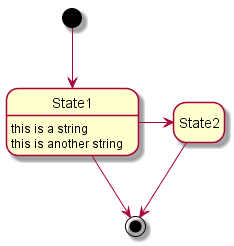
合成状态
一个状态也可能是合成的,必须使用关键字state和花括号来定义合成状态
@startuml scale 350 width [*] --> NotShooting state NotShooting { [*] --> Idle Idle --> Configuring : EvConfig Configuring --> Idle : EvConfig } state Configuring { [*] --> NewValueSelection NewValueSelection --> NewValuePreview : EvNewValue NewValuePreview --> NewValueSelection : EvNewValueRejected NewValuePreview --> NewValueSelection : EvNewValueSaved state NewValuePreview { State1 -> State2 } } @enduml

长名字
可以使用关键字state定义长名字状态
@startuml scale 600 width [*] -> State1 State1 --> State2 : Succeeded State1 --> [*] : Aborted State2 --> State3 : Succeeded State2 --> [*] : Aborted state State3 { state "Accumulate Enough Data\nLong State Name" as long1 long1 : Just a test [*] --> long1 long1 --> long1 : New Data long1 --> ProcessData : Enough Data } State3 --> State3 : Failed State3 --> [*] : Succeeded / Save Result State3 --> [*] : Aborted @enduml

并发状态
用-- or ||作为分隔符来合成并发状态
@startuml [*] --> Active state Active { [*] -> NumLockOff NumLockOff --> NumLockOn : EvNumLockPressed NumLockOn --> NumLockOff : EvNumLockPressed -- [*] -> CapsLockOff CapsLockOff --> CapsLockOn : EvCapsLockPressed CapsLockOn --> CapsLockOff : EvCapsLockPressed -- [*] -> ScrollLockOff ScrollLockOff --> ScrollLockOn : EvCapsLockPressed ScrollLockOn --> ScrollLockOff : EvCapsLockPressed } @enduml
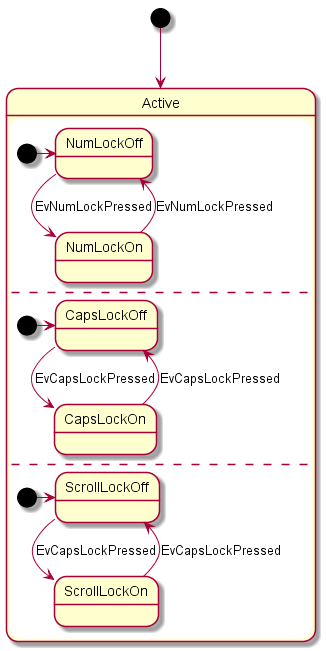
箭头方向
使用->定义水平箭头,也可以使用下列格式强制设置箭头方向:
- -down->(default arrow)
- -right->or->
- -left->
- -up->
@startuml [*] -up-> First First -right-> Second Second --> Third Third -left-> Last @enduml
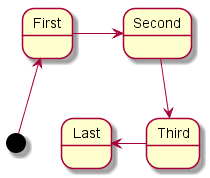
注释
可以用 note left of, note right of, note top of, note bottom of 关键字来定义注释,还可以定义多行注释
@startuml [*] --> Active Active --> Inactive note left of Active : this is a short\nnote note right of Inactive A note can also be defined on several lines end note @enduml
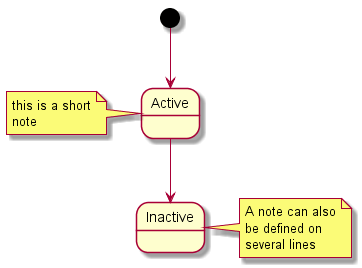
更多注释
可以在合成状态中放置注释
@startuml [*] --> NotShooting state "Not Shooting State" as NotShooting { state "Idle mode" as Idle state "Configuring mode" as Configuring [*] --> Idle Idle --> Configuring : EvConfig Configuring --> Idle : EvConfig } note right of NotShooting : This is a note on a composite state @enduml

显示参数
用skinparam改变字体和颜色:
- 在图示的定义中
- 在引入的文件中
- 在命令行或者ANT任务提供的配置文件中
还可以为状态的构造类型指定特殊的字体和颜色
@startuml skinparam backgroundColor LightYellow skinparam state { StartColor MediumBlue EndColor Red BackgroundColor Peru BackgroundColor<<Warning>> Olive BorderColor Gray FontName Impact } [*] --> NotShooting state "Not Shooting State" as NotShooting { state "Idle mode" as Idle <<Warning>> state "Configuring mode" as Configuring [*] --> Idle Idle --> Configuring : EvConfig Configuring --> Idle : EvConfig } NotShooting --> [*] @enduml

二、《电梯控制》系统、《银行账户》系统
(1)电梯控制
- 电梯存在待载、上升、下降、和楼间停4钟基本状态。
- 电梯无人承载时停在某一楼层,处在待载状态。
- 当有人进入电梯,并且当前楼层比目标楼层低,电梯上升。
- 当前楼层比目标楼层高,电梯下降。
- 所有人都在本层下电梯,电梯回到待载状态。
- 电梯中还有人,判断目标楼层是否比当前楼层高,高则上升,低则下降。
(2)银行账户
- 银行账户存在空额、有余额、负债三种状态。
- 初建立的账户没有存款,处于空额状态。
- 空额状态,向其中存款,进入有余额状态;从账户取款,进入负债状态。
- 在有余额状态时,向账户存款,余额增加,但还是处于有余额状态。
- 账户取款,取款额小于余额,处于有余额状态;等于余额,回到空额状态;大于余额,进入负债状态。
- 负债时,取款,余额减少,还是负债状态;存款,存款额小于负债额,还是负债;存款额等于负债额,回到空额状态;存款额大于负债额,进入有余额状态。
电梯系统:
@startuml [*] --> 待载 待载 --> 上升:进入[目标楼层>当前楼层]/关门上行 待载 --> 下降:进入[目标楼层<当前楼层]/关门下行 上升 -> 楼间停:[进人/出人]/停机开门 下降 -> 楼间停:[进人/出人]/停机开门 楼间停 -> 上升:[目标楼层>当前楼层]/关门上行 楼间停 -> 下降:[目标楼层<当前楼层]/关门下行 楼间停 -left-> 待载:[无人]/关门 @enduml
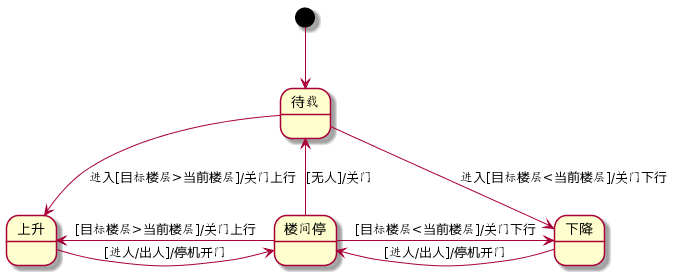
银行系统:
@startuml [*] -> 空额 空额 -> [*] 空额 ----> 有余额:存款/余额=余额+存款额 空额 ----> 负债取款:[取款额<最大限额]/余额=余额-存款额 有余额 -left-> 有余额:存款/余额=余额+存款额 有余额 -right-> 有余额:取款[取款额<余额]/余额=余额-取款额 有余额 --> 负债 有余额 --> 空额 负债 -> 负债:取款[取款额<最大限额]/余额=余额-存款额 负债 -> 负债 负债 --> 有余额 负债 --> 空额 @enduml





 浙公网安备 33010602011771号
浙公网安备 33010602011771号